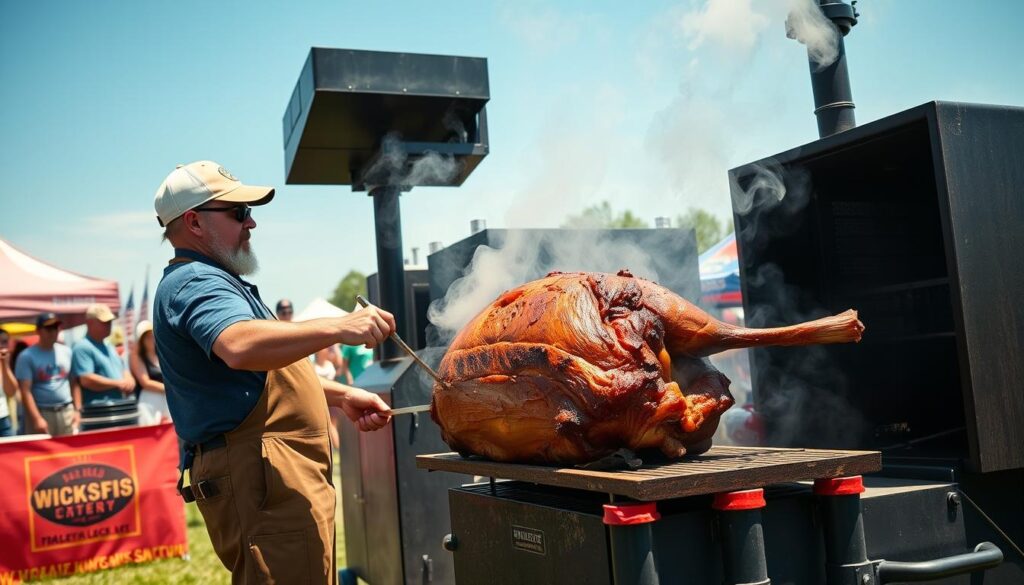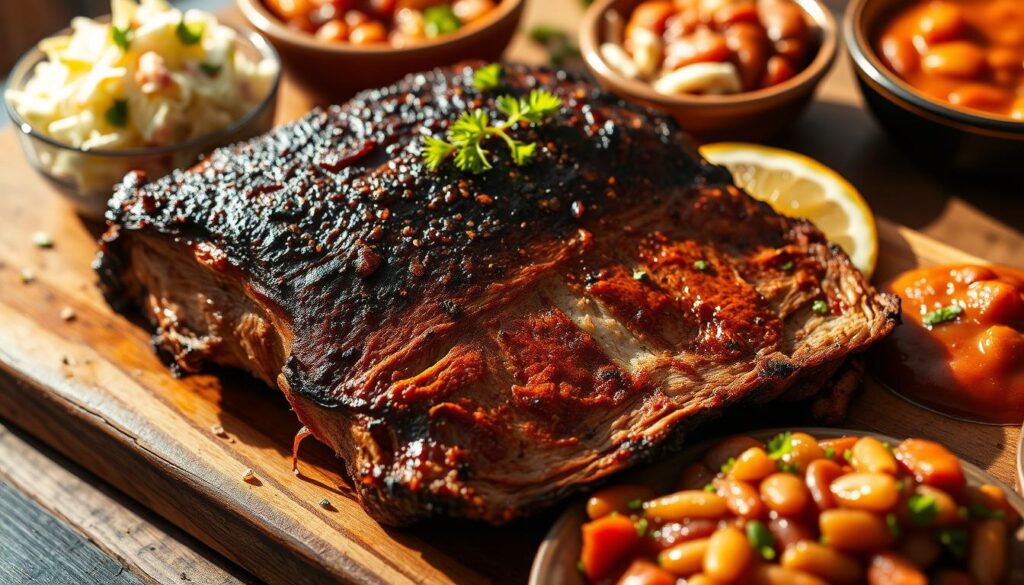How to Smoke Pork Shoulder for BBQ Competitions
Do you dream of being a top pit master in BBQ competitions? The key to winning is mastering the art of smoking the perfect pork shoulder. But what makes that pulled pork so irresistible? Let’s dive into the secrets that will turn your backyard BBQ into a hit.
Key Takeaways
- Learn the essential steps to prepare and smoke pork shoulder for BBQ competitions
- Discover the importance of pork butt selection and how to identify the “money muscle”
- Explore the art of seasoning, smoking, and wrapping techniques to enhance flavor and texture
- Understand the critical role of temperature control and resting the meat for competition-winning results
- Gain insider tips on presentation and serving to impress the judges
The Perfect Bite: Competition-Style Pulled Pork
Getting the perfect bite of competition-style pulled pork starts with knowing the pork butt, or Boston butt. This cut comes from the pig’s shoulder. It’s loved by BBQ fans for its high fat and tender texture when cooked slowly.
Setting the Stage for Delicious Pork
The pork butt is often mixed up with the actual butt. But it’s a top choice for pulled pork. Its fat and muscle fibers are perfect for slow cooking. This makes it easy to get that “pull-apart” texture.
Understanding Pork Butt Cuts
- The pork butt, also known as the Boston butt, is a cut from the upper shoulder of the pig, not the actual butt.
- This cut is characterized by a solid layer of fat, typically around 1/4 inch thick, which helps to keep the meat moist and flavorful during the smoking process.
- The “money muscle,” a small, cylindrical-shaped portion of the pork butt, is considered the most tender and succulent part, making it a highly sought-after section for competition-style pulled pork.
Knowing the pork butt’s unique traits is key to making perfect pulled pork. By picking the right cut and preparing it well, you can boost your BBQ skills. This will impress even the toughest judges.
Selecting the Ideal Pork Butt
Choosing the right pork butt is key for competition-style pulled pork. The size, fat cap thickness, and finding the “money muscle” are important. These factors can help you win over the judges and take the top spot.
Size and Fat Cap Considerations
The best pork butt for competition should weigh between 8-10 lbs. This size offers a good balance of tenderness and size. The fat cap should be about 1/4 inch thick. This thickness keeps the meat moist and adds flavor, also creating a tasty bark on the outside.
The Elusive Money Muscle
The “money muscle” is a tender, cylindrical part of the pork butt. It’s crucial to find and keep this section in top shape for the judges. When picking your pork butt, make sure to spot and check the money muscle. It should be in great condition, ready to show off your cooking skills.
| Characteristic | Ideal Competition Pork Butt |
|---|---|
| Size | 8-10 lbs |
| Fat Cap Thickness | 1/4 inch |
| Money Muscle | Identifiable and in excellent condition |
“The key to winning a BBQ competition is in the selection and preparation of the pork butt. Get that right, and you’re well on your way to a championship-worthy pulled pork.”
Preparing the Pork Butt
Smoking the perfect pork shoulder for BBQ competitions begins with proper preparation. The first key step is to score the fat cap on the meat. This lets the seasoning rubs go deep into the pork, making every bite full of flavor.
Scoring the Fat Cap
Use a sharp knife to make a crosshatch pattern across the fat cap. Cut through the fat but not the meat. Aim for a depth of about 1/4 inch. This grid-like pattern aids in the pork butt preparation process.
Applying Binders and Seasonings
After scoring the fat cap, apply a binder. Use a light coating of mustard or olive oil to help the seasoning rubs stick. Cover the entire pork butt with your favorite dry rub. Choose a rub rich in sugar and salt, as the big pork butt needs lots of seasoning for that winning taste.
With the fat cap scoring and binder application done, your pork butt is set for the smoker. The effort you put into pork butt preparation will show in the delicious results.
Setting Up the Smoker
Getting your smoker setup right is key for a delicious, tender smoke flavor in your pork shoulder. Choosing the right wood selection is important to match the meat’s natural taste.
Wood Choices for Delicate Smoke Flavor
For smoking pork, a mix of post oak and pecan wood works best. These hardwoods give a gentle, rich smoke flavor that boosts the pork’s sweetness without being too strong.
Adding a bit of apple wood chips can add more depth. Apple wood’s mild fruitiness contrasts nicely with the post oak and pecan’s nuttiness.
- Post oak: Gives a deep, earthy smoke flavor that goes well with pork
- Pecan: Adds a light, sweet smoke flavor that enhances the pork’s taste
- Apple wood chips: Brings a touch of fruity sweetness to the smoke flavor
It’s important to keep the smoke flavor light and balanced. This lets the pork’s natural taste stand out. Before putting the pork in the smoker, wait for the smoke to become blue and thin. This means the smoke is clean and ready for a top-notch dish.
The Smoking Process
Mastering the smoking process is key to getting that perfect pork butt. You need to balance smoking temperature and cooking time well. This balance brings out the best in your pork shoulder.
Temperature and Timing
For smoking pork butt, keep the temperature at about 250°F most of the time. This slow cooking lets the fat and collagen melt, making the meat tender and juicy. Plan to cook it for 1.5 to 2 hours per pound, so a big cut could take 8 to 12 hours.
Spritzing for Bark Development
Regular spritzing is a secret to a great bark development on your pork butt. Mist it with apple juice every 60 to 90 minutes. The sugars in the juice help create a tasty, mahogany bark. This makes the meat look great and taste even better.
| Smoking Temperature | Cooking Time | Bark Development | Pork Butt Spritz |
|---|---|---|---|
| 250°F | 8-12 hours | Caramelized, mahogany-colored | Apple juice, every 60-90 minutes |
“The secret to competition-worthy pork is all in the low and slow smoking process. It’s a labor of love, but the end result is worth every minute.”
Smoke pork shoulder for BBQ competitions
As you near the end of smoking your pork shoulder for a BBQ contest, focus on wrapping and checking the temperature. This is key to making your pork shoulder stand out.
The Wrapping Technique
When your pork butt hits 165-175°F and looks great, move it to an aluminum pan. Douse it with apple juice, then wrap it in heavy-duty foil tightly. This method finishes the fat and collagen, making the meat tender and juicy.
Monitoring for Tenderness
Keep an eye on the pork shoulder’s internal temperature, aiming for 200-205°F. Use a digital thermometer to check for tenderness. You want it to be so tender that the “money muscle” pulls apart easily, showing off your smoking skills.
| Step | Description |
|---|---|
| 1. Wrap in Foil | Transfer the pork butt to an aluminum pan, sprinkle with apple juice, and tightly wrap in heavy-duty foil. |
| 2. Monitor Temperature | Aim for an internal temperature of 200-205°F, checking regularly with a digital thermometer. |
| 3. Check for Tenderness | Probe the meat to ensure the “money muscle” is tender and easily pulled apart. |

Mastering the wrapping and temperature checking will lead to a tender, juicy, and top-notch pork shoulder for competitions.
Resting the Pork Butt
After smoking the pork butt to perfection, the next step is just as important. This step lets the meat soak up its juices. This makes the meat tender and full of flavor. It will make your taste buds happy and impress your BBQ friends.
Insulating for Optimal Rest
It’s key to keep the pork butt warm and juicy after cooking. Move the meat to a warm place, like a Cambro Go Box or a cooler with towels. This keeps the meat warm for at least 30 minutes, or up to 4 hours if you need to.
Keep an eye on the pork butt temperature while it rests. This makes sure it stays in the perfect range for temperature maintenance. It keeps your pulled pork moist and full of flavor.
Patience is important here. Letting the pork butt rest is key for absorbing juices. This makes your BBQ tender and juicy, setting it apart from others.
Pulling and Serving
As you near the final stage of your pork butt preparation for the competition, it’s time to focus on the art of pork pulling techniques. The key is to preserve the integrity of the “money muscle” – the most tender and succulent part of the pork butt. Begin by carefully separating the muscles, removing any leftover membranes, fat, or cartilage to ensure a clean, uniform presentation.
Preserving the Money Muscle
The money muscle, a small, cylindrical-shaped portion of the pork butt, is the prized jewel of your competition entry. Treat it with the utmost care, gently pulling and shredding the meat to maintain its delicate texture and juicy flavor. This attention to detail will set your pulled pork apart from the rest, impressing the judges with its melt-in-your-mouth tenderness.
Final Seasoning Adjustments
- Once the pork is pulled, take a moment to assess the final seasoning adjustments needed to enhance the overall flavor profile.
- Consider adding a touch more salt, pepper, or your signature barbecue sauce to elevate the taste and ensure a harmonious balance.
- Remember, the money muscle preservation is crucial, so be mindful not to overpower the natural flavors of the meat.
| Pork Pulling Technique | Importance | Tips |
|---|---|---|
| Separating Muscles | Ensures a clean, uniform presentation | Carefully remove any leftover membranes, fat pockets, or cartilage |
| Preserving Money Muscle | Showcases the most tender and succulent part of the pork butt | Gently pull and shred the meat to maintain its delicate texture and juicy flavor |
| Final Seasoning Adjustments | Enhances the overall flavor profile | Add a touch more salt, pepper, or signature barbecue sauce, but don’t overpower the natural flavors |
“The key to a competition-worthy pulled pork is all in the technique – from preserving the money muscle to making those final seasoning touches. It’s a delicate balance that separates the champions from the rest.”
Competition-Winning Flavor Profiles
Getting the perfect flavor for your smoked pork shoulder is all about prep and strategy. Use injection marinades and seasoning rubs wisely. Learn from the Dizzy Pig team, who have won over a hundred BBQ contests with their pulled pork.
Injection Marinades: Infusing Moisture and Flavor
An injection marinade keeps your pork shoulder moist and full of flavor. Mix pork stock, MSG, sugar, and salt to inject into the meat. This adds a savory taste and keeps the pork juicy, avoiding dryness.
Seasoning Rubs: Building a Mouthwatering Bark
Use a dry rub like Dizzy Pig’s Crossroads or Raging River with your injection marinade. These rubs create a tasty bark on the pork, keeping it moist and adding complex flavors. Make sure to coat the pork well, letting the rub form a thick crust during smoking.
Mastering injection marinades and seasoning rubs can take your competition pork to the top. You’ll be on your way to becoming a Pitmaster Champion.
Temperature and Time Mastery
Getting the perfect temperature and managing cooking time is key in smoking pork shoulder for BBQ contests. Experts say these two elements are vital for tender, juicy, and flavorful pork that wows the judges.
A pork butt usually takes about 90 minutes per pound to cook at 250°F. But, the exact time can change based on the meat’s size and the smoker type. It’s important to watch the meat’s internal temperature closely. Aim for 200-205°F for the best tenderness and doneness.
| Temperature Control | Cooking Time Management |
|---|---|
| Maintain a consistent temperature of 250°F in your smoker to ensure even cooking and a tender, juicy pork butt. | Plan for around 90 minutes of cooking time per pound of pork, but be prepared to adjust based on the size of your cut and the specific characteristics of your smoker. |
| Use a reliable meat thermometer to closely monitor the internal temperature of the pork, aiming for 200-205°F for the perfect doneness. | Be patient and resist the urge to open the smoker too frequently, as this can affect the cooking time and smoke penetration. |
Mastering temperature control and cooking time will help you make competition-worthy pork shoulder. This will make your BBQ stand out. Remember, paying attention to details and sticking with the process is crucial for that perfect bite.
“The key to competition-worthy pork is temperature and time mastery. Nail those two elements, and you’ll be well on your way to BBQ glory.”
Wrapping and Resting Techniques
Once your pork butt reaches the right temperature and looks great, it’s time to wrap and rest it. These steps are key for the perfect texture and juiciness. They’ll impress the judges at your next BBQ competition.
Foil Wrapping for Moisture Retention
Wrapping your pork butt in foil tightly is crucial. Before wrapping, add a bit of liquid like apple juice or pork stock. This keeps the juices in and helps the fat and collagen melt, making the meat tender.
Controlled Resting for Texture Perfection
The resting time is as important as smoking. Let your pork butt rest for 1-4 hours, based on its size. This lets the meat relax and the texture get better. The juices will go back into the meat, making it juicy and easy to pull apart.
“Patience and attention to detail are key when it comes to wrapping and resting your competition-worthy pork shoulder. The results will speak for themselves on the judges’ table.”
Presentation and Serving Tips
When serving your smoked pork shoulder in a BBQ competition, how you present it matters a lot. You want to show off your hard work in a way that looks great and makes people want to eat it. Start by shredding the meat by hand. This makes sure you get tender chunks and juicy strands that will really catch the judges’ attention.
After pulling the pork, add some extra seasoning or your special sauce. This can make the flavors even better and show how much effort you put into your recipe.
The money muscle, a tasty and tender part of the pork shoulder, should be the main focus. Make sure it’s easy for the judges to see and admire. This part of the meat is special, so treat it with extra care.
Your dish should look clean, uniform, and inviting. Put the pulled pork in a neat pile, letting its natural beauty stand out. This way, your dish will look great and taste even better.

“The presentation of your pulled pork can make or break your chances in a BBQ competition. Pay close attention to the details and showcase your hard work with pride.”
Remember, judges don’t just taste the food; they also look at how it looks and the details. Mastering how to present smoked pork can help you win the trophy and become known as a BBQ expert.
Conclusion
This guide has shown you how to smoke pork shoulder for BBQ contests. It’s all about expert techniques and knowing how to mix flavors. You’ve learned how to pick the best pork butt, smoke it, wrap it, and rest it. Now, you know how to make your pulled pork stand out and impress the judges.
By using the right seasonings and letting the smoke do its magic, you can make a pork dish that’s both juicy and full of flavor. Stick to the competition pork smoking summary, key techniques, and flavor profiles for top-notch results. This will make your BBQ stand out.
The main aim is to wow the judges with your dish. With the tips and tricks from this article, you’re ready to take your pulled pork to the next level. You’ll be making BBQ that wins awards in no time.

Leave a Reply